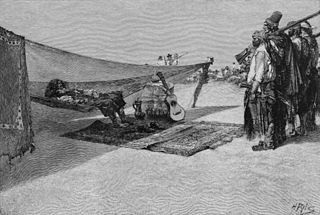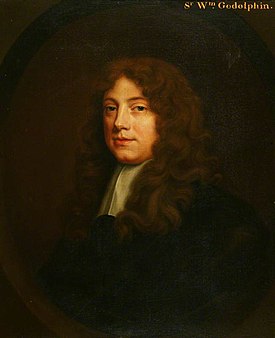
1670 (MDCLXX) was a common year starting on Wednesday of the Gregorian calendar and a common year starting on Saturday of the Julian calendar, the 1670th year of the Common Era (CE) and Anno Domini (AD) designations, the 670th year of the 2nd millennium, the 70th year of the 17th century, and the 1st year of the 1670s decade. As of the start of 1670, the Gregorian calendar was 10 days ahead of the Julian calendar, which remained in localized use until 1923.

Buccaneers were a kind of privateer or free sailors particular to the Caribbean Sea during the 17th and 18th centuries. First established on northern Hispaniola as early as 1625, their heyday was from the Restoration in 1660 until about 1688, during a time when governments in the Caribbean area were not strong enough to suppress them.

Sir Henry Morgan was a Welsh privateer, plantation owner, and, later, Lieutenant Governor of Jamaica. From his base in Port Royal, Jamaica, he and those under his command raided settlements and shipping ports on the Spanish Main, becoming wealthy as they did so. With the prize money and loot from the raids, Morgan purchased three large sugar plantations on Jamaica.

Events from the 15th century in Canada.

The Anglo-Spanish War was a conflict between the English Protectorate under Oliver Cromwell, and Spain, between 1654 and 1660. It was caused by commercial rivalry. Each side attacked the other's commercial and colonial interests in various ways such as privateering and naval expeditions. In 1655, an English amphibious expedition invaded Spanish territory in the Caribbean. In 1657, England formed an alliance with France, merging the Anglo–Spanish war with the larger Franco-Spanish War resulting in major land actions that took place in the Spanish Netherlands.

The Asiento de Negros was a monopoly contract between the Spanish Crown and various merchants for the right to provide enslaved Africans to colonies in the Spanish Americas. The Spanish Empire rarely engaged in the transatlantic slave trade directly from Africa itself, choosing instead to contract out the importation to foreign merchants from nations more prominent in that part of the world, typically Portuguese and Genoese, but later the Dutch, French, and British. The Asiento did not concern French or British Caribbean but Spanish America.

Robert Searle was one of the earliest and most active of the English buccaneers on Jamaica.
John Morris was an English buccaneer active in the Caribbean during the 1660s and early-1670s. His son, John Morris the Younger, held a command of his own ship during his father's later expeditions against Portobelo and Maracaibo. John Morris the Younger was one of the commanders killed in an explosion during a party on board Henry Morgan's flagship in 1670.

The Brethren or Brethren of the Coast were a loose coalition of pirates and buccaneers that were active in the seventeenth and eighteenth centuries in the Atlantic Ocean, Caribbean Sea, and Gulf of Mexico. They mostly operated in two locations, the island of Tortuga off the coast of Haiti and in the city of Port Royal on the island of Jamaica.
Colonel Sir Thomas Modyford, 1st Baronet was a planter of Barbados and Governor of Jamaica from 1664 to 1671.
This timeline of the history of piracy in the 1670s is a chronological list of key events involving pirates between 1670 and 1679.

Portugal and Spain enjoy a friendly relationship. They are both members of the Ibero-American Summit, Council of Europe, European Union, Eurozone, Schengen Area and NATO, and make up the vast majority of the Iberian Peninsula.

The Western Design was an English expedition against the Spanish West Indies during the 1654 to 1660 Anglo-Spanish War.

The Invasion of Jamaica took place in May 1655, during the 1654 to 1660 Anglo-Spanish War, when an English expeditionary force captured Spanish Jamaica. It was part of an ambitious plan by Oliver Cromwell to acquire new colonies in the Americas, known as the Western Design.
Sir Thomas Lynch was the English governor of Jamaica on three separate occasions in the 17th century. He was also chief justice of Jamaica for a time.

The English overseas possessions, also known as the English colonial empire, comprised a variety of overseas territories that were colonised, conquered, or otherwise acquired by the former Kingdom of England during the centuries before the Acts of Union of 1707 between the Kingdom of England and the Kingdom of Scotland created the Kingdom of Great Britain. The many English possessions then became the foundation of the British Empire and its fast-growing naval and mercantile power, which until then had yet to overtake those of the Dutch Republic, the Kingdom of Portugal, and the Crown of Castile.

Santiago was a Spanish territory of the Spanish West Indies and within the Viceroyalty of New Spain, in the Caribbean region. Its location is the present-day island and nation of Jamaica.

Jamaican nationality law is regulated by the 1962 Constitution of Jamaica, as amended; the Nationality Act of 1962, and its revisions; and various British Nationality laws. These laws determine who is, or is eligible to be, a national of Jamaica. Jamaican nationality is typically obtained either on the principle of jus soli, i.e. by birth in Jamaica; or under the rules of jus sanguinis, i.e. by birth abroad to parents with Jamaican nationality. It can also be granted to persons with an affiliation to the country, or to a permanent resident who has lived in the country for a given period of time through naturalisation. There is not currently a program in Jamaica for persons to acquire nationality through investment in the country. Nationality establishes one's international identity as a member of a sovereign nation. Though it is not synonymous with citizenship, for rights granted under domestic law for domestic purposes, the United Kingdom, and thus the commonwealth, have traditionally used the words interchangeably.

The Treaty of Madrid, also known as the Earl of Sandwich's Treaty, was signed on 23 May, 1667 by England and Spain. It was one of a series of agreements made in response to French expansion under King Louis XIV.

Henry Morgan's Panama expedition also known as the Sack of Panama, was an expedition that took place between 16 December 1670 and 5 March 1671 during the later stage of the Anglo-Spanish War. English privateers and French pirates commanded by notable Buccaneer Henry Morgan launched an attack with an army of 1,400 men with the purpose of capturing the rich Spanish city of Panama off the Pacific coast.

















